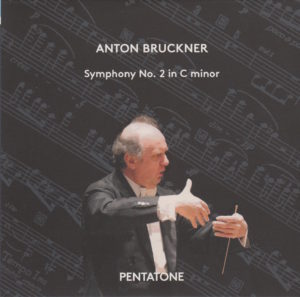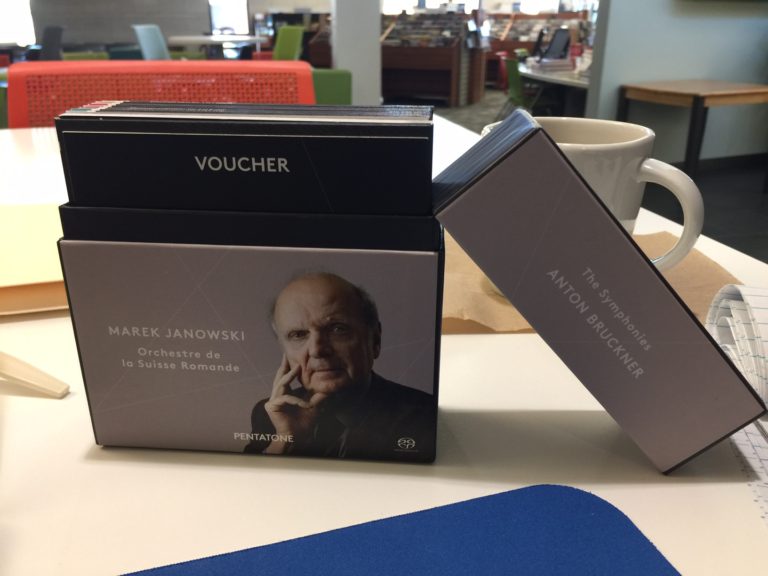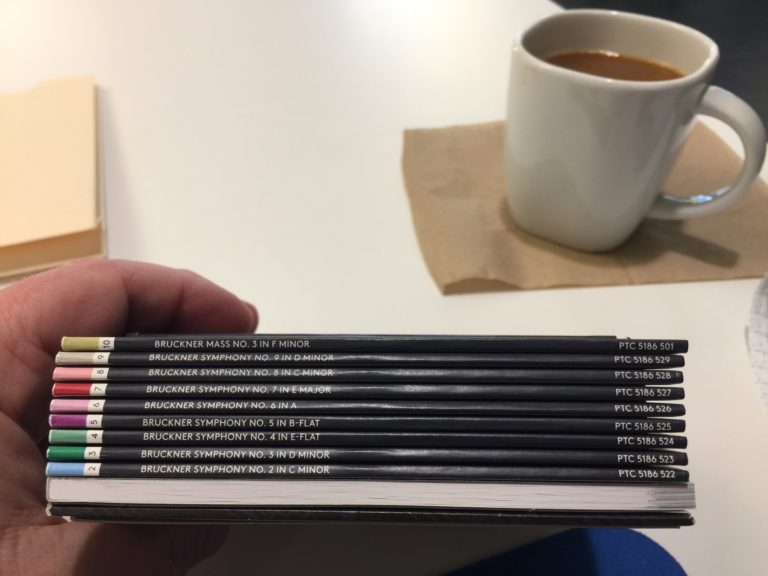 My “office” this morning: Starbucks, the iconic coffee shop that’s as snooty and hipster as they come.
My “office” this morning: Starbucks, the iconic coffee shop that’s as snooty and hipster as they come.
My dutiful wife sits nearby, ostensibly to work. But she’s actually just farting around on her smart phone.
Still, it’s nice to have someone with me for a change.
 This morning, I am listening to Anton Bruckner’s Symphony No. 2 in C Minor (WAB 102), nicknamed “The Symphony of Pauses,” interpreted by Polish-born German conductor Marek Janowski (1939-).
This morning, I am listening to Anton Bruckner’s Symphony No. 2 in C Minor (WAB 102), nicknamed “The Symphony of Pauses,” interpreted by Polish-born German conductor Marek Janowski (1939-).
Janowski is another conductor about whom I knew nothing until readers of my web site 144 Days With Bruckner and Me told me I should consider listening to him.
So I did consider it.
And here I am listening to him.
[NOTE: That’s the last time I’ll mention that anecdote, too, as well as bio info about Janowski.]
Part of the reason why I start these vast music projects is to learn about the conductors, orchestras, and venues, as well as the composers and their music. So I’m more than happy to do research on Janowski.
According to his entry on Wikipedia,
Janowski grew up in Wuppertal near Cologne, Germany after his mother traveled there at the start of World War II to be with her parents. His father disappeared in Poland during the war.
Janowski has served as music director in Freiburg and at the Dortmund Opera conducting the Dortmunder Philharmoniker, the latter from 1973 to 1979. He served as Kapellmeister of the Gürzenich Orchestra in Cologne, from 1986 to 1990. Earlier, in 1984, he became the music director of the Orchestre Philharmonique de Radio France (then called the Nouvel Orchestre Philharmonique) in Paris, a position he held until 2000. From 2000 to 2009, Janowski served as Principal Conductor of the Monte-Carlo Philharmonic Orchestra. He was also Principal Conductor of the Dresden Philharmonic from 2001 to 2004.
Janowski has conducted most of the major opera houses of the world (including Arabella, Salome and Die Entführung aus dem Serail at the Metropolitan Opera). He has made a number of operatic recordings, including the first digital recording of the complete Ring Cycle of Richard Wagner between 1980 and 1983 for RCA, with the Staatskapelle Dresden.
His orchestra is Orchestre de la Suisse Romande.
According to its entry on Wikipedia,
The Orchestre de la Suisse Romande (OSR) is a Swiss symphony orchestra, based in Geneva at the Victoria Hall. In addition to symphony concerts, the OSR performs as the opera orchestra in productions at the Grand Théâtre de Genève.
Ernest Ansermet founded the OSR in 1918, with a contingent of 48 players and a season of six months’ duration. Besides Swiss musicians, the OSR players initially came from other countries, including Austria, France, Germany and Italy. Ansermet gradually increased the percentage of Swiss musicians in the orchestra, attaining 80% Swiss personnel by 1946. Ansermet remained the music director of the OSR for 49 years, from 1918 to 1967.
Of special note this morning is the CD box set containing Maestro Janowski’s interpretation of Bruckner’s Second, as well as the record label that released it.
The Pentatone label is carving out a niche for itself as the high-end source for audiophiles of Classical music. Everything about this Janowski box set – like the Georg Tintner box set released by Naxos I reviewed in my 144 days site – screams high quality. In fact, if I was going to release a cycle of a conductor’s symphonies, and I wanted to do it right, I’d do it this way (or the Naxos way).
The Pentatone box is made of heavy cardboard with a top that slides off, just like the CD box from Naxos.

Inside is a treasure trove of CDs, a massive booklet of notes, and even a voucher for a free album download.

I’m tellin’ ya, this is a keepsake box, the material given the treatment it deserves.
Anyway, from its entry on Wikipedia,
Pentatone (stylized as PENTATONE) is a Dutch classical music label specialising in high-end, 5-channel surround sound recordings.
Pentatone was founded in 2001 by three former executives of Philips Classics, Giel Bessels, Dirk van Dijk and Job Maarse. Its catalogue includes recordings by conductors Kent Nagano, Sir Neville Marriner, Mikhail Pletnev, Sir Colin Davis, Yakov Kreizberg, Simon Murphy and Lawrence Foster; instrumentalists Julia Fischer, Martin Helmchen, Mari Kodama, Arabella Steinbacher and Nareh Arghamanyan; and orchestras such as The Russian National Orchestra, The Wiener Symphoniker, The New Dutch Academy, the Bolshoi Opera and many others. Pentatone has also recorded a complete set of Richard Wagner’s operas by the Rundfunk Sinfonieorchester, conducted by Marek Janowski.
And there you have it – background on the conductor, the orchestra, and the record label that released the box set to which I’m listening this morning.
You’re welcome.
Here are the objective aspects of today’s recording:
 Bruckner’s Symphony No. 2 in C Minor (WAB 102), composed 1872
Bruckner’s Symphony No. 2 in C Minor (WAB 102), composed 1872
Marek Janowski conducts
Janowski used the “Version 1877, William Carragan Edition,” according to the back of the CD sleeve
Orchestre de la Suisse Romande plays
The symphony clocks in at 54:55
This was recorded at Victoria Hall, Geneva, Switzerland, in October of 2012
Janowski was 73 when he conducted it
Bruckner was 48 when he finished composing it (the first time)
This recording was released on the Pentatone label
Bruckner wrote his symphonies in four movements. The time breakdown of this one (Symphony No. 2 in C Minor), from this particular conductor (Janowski) and this particular orchestra (Orchestre de la Suisse Romande) is as follows:
I. Moderato……………………………………………………………………………………………………..17:47
II. Andante: Feierlich, etwas bewegt (Solemnly, somewhat animated)…………14:21
III. Scherzo: Mäßig schnell (Moderately fast)……………………………………………………8:46
IV. Finale: Ziemlich schnell (Fairly fast)……………………………………………………………13:58
The score calls for a pair each of flutes, oboes, clarinets, bassoons, four horns, two trumpets, three trombones, timpani, and strings.
Total running time: 54:55
Here’s a quote from the superb CD booklet written by Franz Steiger:
To this day, the Symphony No. 2 in C minor remains the least frequently performed symphonic work by Anton Bruckner. It is not as revolutionary as the first, nor as brutally rampant as the third: rather, it represents a kind of “retarding element” (Manfred Wagner), although certainly not a “step backwards”; however, thanks to its peculiar unwieldiness and highly complex content, it possesses a highly independent symphonic nature.
In his second symphony, Bruckner’s omnipresent “version problem” manifests itself with great clarity for the first time. Three versions of the work exist…only a few years ago, the vesrions from 1872 and 1877 were presented as part of the “New Complete Edition” by William Carragan in two volumes, and this recording is based on the latter.
William Carragan, in case you’d like to know, is part of the wonderful and robust Anton Bruckner group on Facebook. Here’s a link to the group. (NOTE: you must be a member of Facebook to view the content of the group. It’s a closed group.)
Okay. Now, here are the subjective aspects of today’s recording:
My Rating:
Recording quality: 5
Overall musicianship: 5
CD liner notes: 5 (big, thick, substantive booklet with insightful essays about the symphonies, the orchestra, and the conductor translated into English, German, and French)
How does this make me feel: 5
The one word the comes to mind when I listen to Janowski’s interpretation of Bruckner’s Second is “vast.”
Everything about this symphony is big, grand, exceptional – from the way it was recorded, to the magical way it was performed, to the inspired way it was conducted, to William Carragan’s cohesive edition.
The movement that sounds particularly “big” or “vast” is the Scherzo (movement III). That begins with bold pronouncements that echo in a stately way.
This is a superb recording with each instrument given full space to be heard. That’s especially noticeable in the Andante and the aforementioned Scherzo.
I’m extremely impressed with this recording and the first two performances from the Janowski box from Pentatone.
The instruments are recorded exceptionally well, with space given to hear every single one. I don’t get the “brassy” tone from the horns that I sometimes do with I listen to these recorded symphonies. But I do hear instruments I don’t normally hear.
Seriously, people. This CD box set from Pentatone is head and shoulders above anything else I’ve heard so far.
Just FYI.
